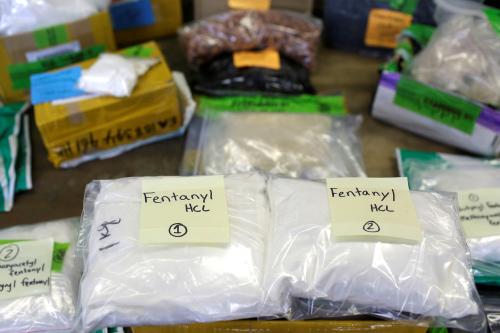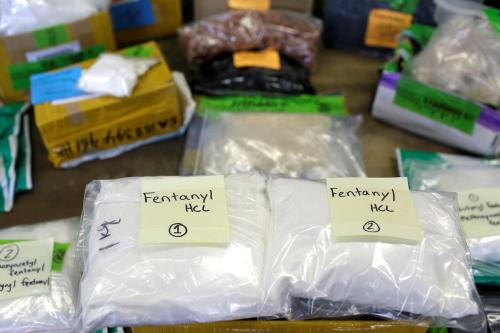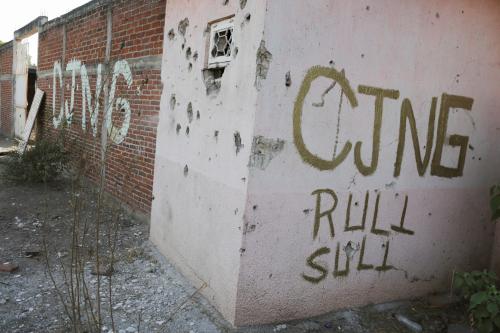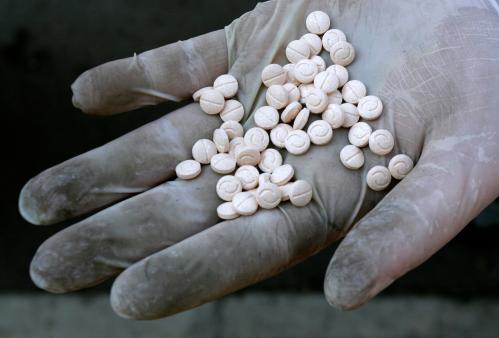Over 81,000 Americans died of drug overdoses between June 2019 and May 2020. It was the highest number of overdose deaths ever recorded in U.S. history, driven in large part by a near-40% increase in deaths attributable to synthetic opioids, like fentanyl and its analogues. This staggering increase does not account for the also-shocking over 26% increase in deaths attributable to cocaine overdose, which can also be linked to the rising prevalence of cocaine being cut with synthetic opioids like fentanyl.
It’s likely that these numbers will continue to rise for a whole host of reasons, not the least of which is the Biden administration’s focus on trying to turn the tide on America’s dismal COVID-19 response. Vanquishing the threat of COVID-19 is, of course, a righteous effort, long in coming, and to its credit the administration has paid heed to the unique threat the opioid epidemic poses to Americans from almost the start.
But, there are things the Biden administration can do right now — beyond the largely demand-side focus we can expect — to address the special risk posed by synthetic opioids, like fentanyl, delivered by drone at or near the U.S. border.
Understanding the synthetic opioids threat
There are several traits of synthetic opioids, like fentanyl, that make them particularly dangerous. First, this family of drugs are lab-made. This means that, like an even more shadowy version of the methamphetamine cooked up by Walter White in the television show “Breaking Bad” (if you can imagine that), regulators and law enforcement often find themselves in a game of catch-up with chemists on illicit payrolls. Drug makers can tweak the drugs’ chemical formulas to escape application of regulatory definition, make the drugs harder to detect, and even increase their potency.
Second, fentanyl in particular has legitimate medical uses. Originally designed and intended as a more powerful, faster-working alternative to morphine for surgery and post-operative pain management, it is still widely used medically. Thus, the world’s major drug-producing nations — China and increasingly India — have a robust pharmaceutical industry that caters to the legitimate demand, and in doing so produce, stockpile, and sell the precursor chemicals necessary to manufacture synthetic opioids. China is the primary supplier of fentanyl to the whole of North America. Its sales, both legitimate and not, of fentanyl and its precursors to Mexico are especially problematic given the rise in power and boldness of technologically savvy drug cartels and transnational criminal organizations (TCOs). These groups operate with near impunity in Mexico despite the “best efforts” of the feckless López-Obrador administration.
Third, and most importantly, synthetic opioids tend to be extraordinarily potent: in some cases up to 30 times stronger than heroin. While this potency makes synthetic opioids attractive to hard-core illegal drug users, the conventional wisdom is that the vast majority of the U.S. synthetic opioid demand is dealer-driven, in that most drug users are looking to score OxyContin or heroin, but often end up with product containing fentanyl or an analog without the user’s knowledge. Synthetic opioids are cheaper to produce, and dealers can acquire alternatives to name-brand OxyContin or traditionally sourced heroin. They can also add synthetic opioids to the mix of cutting agents to extend supplies, because a small amount of synthetic opioid can mimic the potency of a large amount of other drugs. Indeed, it is this potency that makes even minuscule amounts fatal, but at the same time makes these drugs so profitable and so easy to smuggle.
A perfect storm
Synthetic opioids delivered by drone from Mexican TCOs creates a perfect storm of risk to Americans. First, the López-Obrador administration, under the guise of making Mexico and Mexicans safer, has essentially given up on any sort of meaningful domestic enforcement activities that would directly challenge the cartels and TCOs. This stance has not only helped establish Mexico’s devastatingly high murder rate, but has also directly contributed to Mexico’s own rapidly growing synthetic opioid problem.
Mexican leadership doubled-down by passing a new National Security Act that significantly hamstrings U.S. counter-drug enforcement efforts in Mexico. The timing of this act was notable: Under pressure from Mexico, the United States had just dropped its charges against Mexican Army General Salvador Cienfuegos Zepeda, and there was a complete lack of follow-up by Mexican criminal authorities. Even the most ardent sovereigntist would question whether the López-Obrador administration is just feckless or if perhaps there are more sinister (and corrupt) forces at play. In short, the United States can count on little, if any, effective counter-narcotics enforcement support from the Mexican side of the border.
Mexico’s lack of real effort, coupled with the rapid development of 21st-century technology — especially drone technology — makes it easier for TCOs to move meaningful quantities of highly potent synthetic opioids, along with other drugs laced or cut with synthetic opioids, into the United States. And thus, to reverse the trend of growing U.S. overdose deaths, the Biden administration will need new and robust demand-side and supply-side efforts. This should include, in the words of the National Security Council press office, “doing more to target money laundering, pre-cursor chemicals, the role of China in fentanyl trafficking through Mexico, as well as investing in economic opportunity and crime prevention.” But, for now, let’s focus on how drones will change the drug smuggling game and some of the things the United States can do about it.
The challenge of regulating drones
Countering unmanned aviation systems (CUAS) is a devilishly complex legal and operational subject.
From a legal standpoint, drones are considered aircraft in the United States and thus fall under the regulatory ambit of the Department of Transportation (DOT)’s Federal Aviation Administration (FAA). It is a U.S. federal criminal violation to interfere with or with wrongful intent, seize the operation of an aircraft, even a drone. Doing so using electronic means could implicate the Computer Fraud and Abuse Act, another federal criminal statute. Intercepting, jamming, or interfering with drone control electronic signals specifically implicate several other federal criminal statutes, like the Pen/Trap Statutes and the Wiretap Act both of which generally require law enforcement to obtain a warrant or court order before intercepting an electronic transmission. And this is just a sampling of the legal landscape and doesn’t address state law or the civil liability aspects of CUAS activities.
Operationally, drones are difficult to detect, difficult to discern legitimate versus illegitimate use, difficult to interdict using kinetic means, and — with ever-increasing effective operational ranges, including programmable GPS-based flight paths — difficult to attribute operational control of.
Congress partially addressed these issues in the Preventing Emerging Threats Act (PEMA), included as Division H of the FAA Reauthorization Act of 2018. PEMA, largely modelled after similar legal authority granted to the Department of Defense for the defense of its personnel, bases, and assets in the United States, provides the Department of Homeland Security (including its components like Customs and Border Protection [CBP], Secret Service, and the Coast Guard) and the Department of Justice (including its components like the Federal Bureau of Investigation, the U.S. Marshal Service, Drug Enforcement Administration, and the Bureau of Prisons) affirmative authority to employ CUAS, in close coordination with DOT/FAA, in the execution of certain missions.
PEMA was a good start, but there is still room to improve in this context. First, CBP has yet to operationalize the authority at the border. CBP is most certainly working on it, but the faster it develops the necessary doctrine and fields a viable CUAS capability along the border, the better. The threat of drone drug smuggling on the border grows by the day as drones become more capable in terms of range and cargo capacity, and is especially pronounced when one considers the tremendous potency of even small amounts of synthetic opioids. Relatively small, drone-delivered, synthetic opioid cargo can mean the deaths of hundreds, perhaps thousands. And swarmed drone-deliveries en masse could simply be devastating. The Biden administration should thus prioritize CBP’s CUAS operationalization as an opening entrée into technological alternatives to the prior administration’s border wall — and it should do so now, before the border drone threat grows to an unmanageable level.
Second, while PEMA opened the door for federal CUAS operations on the border (and elsewhere) it did not provide similar authority for state, local, tribal, and territorial (SLTT) law enforcement. This is perhaps understandable considering the relative novelty of the drone threat in what is now better understood to be a wide variety of security contexts and Congress’ clear discomfort around the idea in general, evident in some of the restrictive language and oversight requirements included in the law. But, given the long-standing federal reliance on SLTT law enforcement partners for immigration enforcement, narrowly expanding this authority to such partners at or near the border may be a great way to “beta test” its use more broadly. It is, after all, a big sky — one rapidly filling with drones of all types. This means that there will inevitably be drone-based threats in the United States beyond drug smuggling and they’re coming sooner than we’re currently prepared for. While SLTT arguably have inherent self-defense authority to engage in CUAS activities to counter an imminent drone-based threat of death or serious injury to the public or themselves, it is far better from a risk management standpoint — legal and otherwise — if SLTT had similar express authority to what PEMA provides their federal counterparts. Trying it out in the limited context of border security force multipliers seems a reasonable first step.
Congress could mitigate risk in several ways. First, it could take a page out of the counter-terror playbook, when there was concern about improvised explosive devices (IEDs) lurking behind every piece of roadside trash. It could mandate federal certification of SLTT CUAS akin to the process the FBI uses to certify SLTT IED technicians as a precondition to receiving affirmative federally supported, PEMA-like authority. As was the case with the specter of domestic IEDs, without SLTT support, federal resources don’t go very far. There just aren’t enough.
Second, and notwithstanding well-trod arguments against partitioning up the air space — a move opposed by a surprisingly powerful model aircraft lobby and less surprising but even more powerful commercial interests — Congress could consider statutorily establishing a drone “no-fly zone” within a certain distance of the U.S.-Mexico border. This could be enacted at least until drone radio frequency identification takes wider hold, and perhaps even beyond, as blending in with legitimate traffic is a tried and true smuggling tactic. Such a zone already exists over Washington, D.C.
The day may soon come when legitimate commerce is crossing the border via drone. Until that can be managed in a safe and orderly fashion, and given the truly unique threat even small amounts of synthetic opioids pose to Americans, it may be best in the near term to adopt a more aggressive enforcement posture around the border. Even establishing a presumptive no-fly zone near the border with geofenced routing and/or registered exceptions for legitimate agriculture, certain non-governmental organization activities, environmental protection, and other government use, would go far in helping CBP identify drone friend from foe.
A smart focus on supply
Transnational criminal organizations have long used developing technology to achieve their ends. They will continue to do so. They’re motivated, agile, and not particularly risk-averse. To beat them, the United States must be the same. Really, it must be better. The Biden administration will seemingly be inclined to focus its counter-drug efforts on treatment, prevention, and harm reduction. This is a principled, reasonable position for a whole host of reasons, but completely abandoning or even significantly decreasing supply-side efforts with respect to Mexican drug trafficking would be a grave mistake.
Now is the time to take action to address the unique threat at the intersection of rapidly developing, easily accessible, highly capable drone technology and the deadly potency of synthetic opioids like fentanyl and its analogues. Doing so would be a smart way for the administration to expend some supply-side effort.
The views expressed are the author’s alone and do not reflect the official policy or position of the United States Coast Guard, U.S. Department of Defense, U.S. Department of Homeland Security, or the U.S. Government.






Commentary
Death from above: How criminal organizations’ use of drones threatens Americans
March 11, 2021